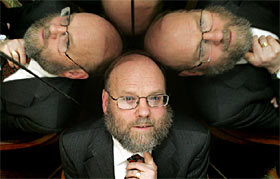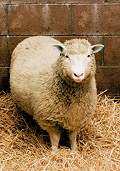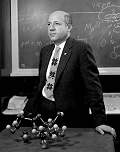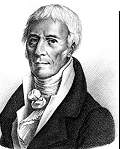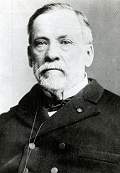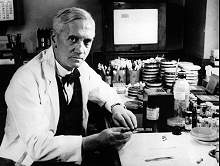| Father (fa'ther) n. an originator, founder or inventor
|
|
By Leigh Fenly UNION-TRIBUNE STAFF WRITER June 15, 2005
Or, surveying other scenes, has anyone ever considered Rush Limbaugh the father of talk radio, or Elvis the father of rock 'n' roll? But in science, the term has never fallen from grace. Fathers abound. Where there is a hypothesis, there is a father – Isaac Newton, father of gravity; Charles Darwin, father of natural selection; Albert Einstein, father of relativity. When Calvin Coolidge supported the idea of a national father's day in 1924, he probably didn't have the list below in mind. It's a personal pick of the fathers of science, including the well-known, the obscure, the discounted, the revered. For many, their unfledged ideas were soundly rejected during their lifetimes, as babies too ugly for polite society.
IAN WILMUT 1944 –CLONING
Since, many other mammals have been cloned – cows, mice, pigs, rabbits, cats and dogs – and Dolly has died. Wilmut's success was heralded as one of the most significant scientific breakthroughs of the 1990s, but it also triggered raucous debate about its ethics. Advocates say the technique – when and if it is perfected – might offer infertile couples the ability to have biologically related children. But others find it a shocking violation of natural processes that could lead to genetic tailoring of offspring. In his Edinburgh lab, Wilmut has taken the storm in stride. "I don't have any sleepless nights," he says. "I believe we are a moral species." MELVIN CALVIN 1911-1997
PHOTOSYNTHESIS
On the day the Japanese surrendered in 1945, Melvin Calvin set out to solve the riddle of photosynthesis. With an interdisciplinary team of chemists, biologists and physicists at UC Berkeley, Calvin methodically traced the paths that carbon-14 travels through a plant during photosynthesis. Developing technology as he went, Calvin tracked carbon-14 from its absorption as carbon dioxide to its conversion into carbohydrates and other organic compounds. This sequence of reactions is called the Calvin Cycle, and its discovery won for its founder the Nobel Prize in 1961. JEAN-BAPTISTE LAMARCK 1744-1829
LAMARCKIANISM
Jean-Baptiste Lamarck – a French naturalist and, until the French Revolution, keeper of the royal gardens – strove to explain the increasing complexity of life forms over time. A half century before Darwin, he set out his ideas on evolution in his "Philosophie Zoologique" in 1809. Lamarck believed that if an organism developed a particular capability during its lifetime, its offspring could inherit that capability – what he called the inheritance of acquired characteristics. His most famous example was the giraffe. Lamarck believed that the giraffe got its long neck because previous generations had stretched to reach tasty shoots on the upper branches of trees. The accepted view now is that evolution favors giraffes that happen to have long necks and that inheritance depends on genes. LOUIS PASTEUR 1822-1895
GERM THEORY OF DISEASE
As a professor of chemistry at Lille, France, Louis Pasteur came to understand that fermentation was a biochemical process – not simply a matter of chemistry, as many had believed – and that it required microorganisms, specifically yeast. Others had come up with the same idea, but Pasteur's work was instrumental in establishing that diseases are caused by microorganisms – and in fact that physicians themselves were spreading childbed fever from woman to woman as they moved from one birthing bed to the next. ALEXANDER FLEMING 1881-1955
ANTIBIOTICS
In 1928, the Scottish bacteriologist Alexander Fleming was experimenting with the bacteria Staphylococcus in his long-term effort to figure out how the human body fights off infection. He noticed that some of the culture dishes had become contaminated by a common mold called penicillium – what turns old bread blue. Around each spot where the mold was growing, Fleming noticed a zone where bacteria could not grow, and he theorized that the mold was producing something that killed the bacteria. Eventually he isolated the molecule we now call penicillin, the first modern antibiotic. Fleming's accidental discovery won him a share of the 1945 Nobel Prize. HENRY ELIOT HOWARD 1873-1940TERRITORIALITY Through a lifetime spent observing birds, Henry Eliot Howard, an obscure English birder, noticed that males establish themselves in certain locations and drive other males of the same species away when they wander in. He also noticed that females were drawn to these areas, and mating and nesting took place within them. Since the 1920s when Howard introduced the term "territory" into the vocabulary of biology, the behavior has been recorded in numerous species. From birds to fish, the general rule is that once a territory is established, it is very difficult for one male to invade the territory of another. BENOIT MANDELBROT 1924-FRACTALS Look closely at the famous Benoit Mandelbrot set of fractals and you'll discover spirals, spikes and zigzags dissolving into spirals, spikes and zigzags – a state of infinite detail. Yet all that endless repetition can be summed up in a single mathematical formula. In the mid-'70s, Mandelbrot coined the word "fractal" to describe such shapes that are made up of smaller copies of themselves. Fractal objects had been described earlier, but the Yale professor was the first to highlight their common properties. In his 1982 book, "The Fractal Geometry of Nature," he emphasized how fractals could be used as models of natural phenomena – to understand the shape of coastlines and river basins, the structure of plants, blood vessels and lungs, the clustering of galaxies. Now fractal math is being used to understand such diverse problems as stock-market prices and the engineering dilemmas of fluid dynamics. KRISTIAN OLAF BIRKELAND 1867-1917AURORA BOREALIS Norwegian scientist Kristian Birkeland was convinced that the northern lights were created by charged particles streaming from the sun being drawn toward the poles by Earth's magnetic field. The lights occurred when the particles collided with atoms in the atmosphere. Birkeland was right, but no one believed him – even though he spent winters in Arctic conditions gathering evidence, created complicated mathematical models to support his field work and even built a machine that re-created the lights in his laboratory. Birkeland wasn't completely vindicated until the late 1960s, when satellite data provided critical proof. DEMOCRITUS 460 TO 370 B.C.ATOMS The Greek philosopher Democritus is generally given credit for being the first to argue that matter is made up of invisible, indivisible parts he called atoms. The word "atom" – about the only thing to survive from Democritus' ideas – comes from the Greek, meaning "that which can not be divided." Like all philosophers of the time, Democritus engaged in "thought experiments," rather than direct observation or experiment. In 1897, when John Joseph Thomson (another father) discovered the electron, it became clear that atoms are made of smaller particles still. JAMES EPHRAIM LOVELOCK 1919-GAIA HYPOTHESIS "Earth is more than just a home; it's a living system, and we are part of it," James Ephraim Lovelock wrote in his 1979 book, "Gaia." According to the ideas of Gaia, such things as the level of oxygen, the formation of clouds and the saltiness of the oceans may be controlled by interacting physical, chemical and biological processes. Lovelock, a former NASA scientist who discovered chlorofluorocarbons (CFCs) in the atmosphere, believes self-regulating processes work together to make Earth a fit place to live. Gaia doesn't really make testable predictions, so it is regarded by many as more of a metaphor for thinking about Earth science rather than doing it. Gaia has, however, brought about more study of planet Earth as a whole, rather than a series of disconnected parts. HENRY WALTER BATES 1825-1892MIMICRY Hungry birds know better than to dine on toxic monarch butterflies. They avoid viceroy butterflies, too, since viceroys look very much like monarchs. Through years of observing and collecting butterflies, Henry Walter Bates learned that viceroys con their predators by piggybacking on the winning strategy of the monarchs. Viceroys may advertise a poisonous look, but they have no toxin. An English naturalist, Bates developed the idea of mimicry – when species are similar in appearance but only one is armed with defensive spines, stingers or toxic chemistry. Mimicry serves either to protect the mimic from its predators, as in the butterflies, or to deceive its prey, in the way that certain ant-eating spiders resemble ants. Natural selection is at work here: If, say, a harmless snake acquires a resemblance to a poisonous variety, it is then more likely to escape its predators and thus to survive and propagate, producing offspring with the same appearance. LUIS ALVAREZ 1911-1988DINOSAUR EXTINCTION In 1980, UC Berkeley researcher Luis Alvarez with his son Walter found high concentrations of iridium in 65 million-year-old sediments. A heavy metal extremely rare on Earth, iridium is more abundant in asteroids. From that finding, Luis, a 1968 Nobelist, and Walter formulated the theory of "The Great Dying," which posits that the dinosaur extinction was caused by the impact of an 7-mile-wide asteroid. An enormous dust cloud, generated by the impact, blanketed Earth for several years, blocking out sunlight and killing most living things on the planet. The theory was greeted with doubt, skepticism and even hostility, but over the years evidence in its favor has appeared. Prominent is the 1992 discovery of the Chicxulub crater in the Yucatan, now widely accepted as the site of the asteroid impact that finished off the dinosaurs. CHARLES LYELL 1797-1875
UNIFORMITARIANISM Charles Lyell believed the present is the key to the past. In 1830, he stated the basic idea of uniformitarianism – that Earth has been shaped gradually by forces that can still be seen operating today. As part of his experiments, Lyell, a Scottish geologist, measured the thickness of lava flows in Sicily to show that Mount Etna could have been built by the slow accumulation of flows. He measured the erosion caused by Niagara Falls and argued that the present position of the falls could be understood in terms of a gradual wearing down of the rocks by the Niagara River. Charles Darwin so admired Lyell that he carried a copy of his book, "Principles of Geology," with him on the Beagle. Lyell, on the other hand, was skeptical of Darwin, and refused to believe that his theory of evolution applied to humans. GREGOR MENDEL 1822-1884GENETICS The first person to trace the characteristics of successive generations was not a famous scientist in his day. Rather he was a Moravian monk who taught natural science to high school students. On one of his frequent walks around the monastery, Gregor Mendel wondered how plants obtain unique characteristics. To find out, he embarked on a series of painstaking experiments cross-breeding two sets of peas. These eventually led him to the notion that heredity is governed by genes. Mendel derived the laws of inheritance and explained characteristics that had long baffled scientists: Why do some diseases skip generations? Why is it that a brown-eyed parent can have a blue-eyed child? Mendel and his work remained in obscurity for decades and was not widely recognized until the early 1900s. Today his short monograph, "Experiments with Plant Hybrids," is considered one of the most influential publications in the history of science. DMITRI MENDELEYEV 1834-1907PERIODIC TABLE Writing an introductory chemistry book in the 1860s, Dmitri Mendeleyev was stumped: How to arrange all these new chemical elements being discovered? The solution, he said, came to him in a dream. Mendeleyev found order by arranging the elements in rows of increasing mass, then arranging the length of the rows so elements in the same column had similar properties. It was more courageous than it might sound. Mendeleyev's table contained gaps for elements not yet discovered. And he had to assume that the weights of several elements had been incorrectly measured. As it turned out, he was right. When Mendeleyev first published the table, it was essentially an observation of a pattern in nature. It wasn't until the advent of quantum mechanics that the table began to make sense in terms of the arrangement of electrons in atoms. ALFRED WEGENER 1880-1930CONTINENTAL DRIFT Alfred Wegener wasn't alone in noticing how the coastlines of South America and Africa fit together like puzzle pieces. But he was the first to develop a theory about it – while a German soldier recovering from injuries during World War I. In his 1915 book, "The Theory of Continental Drift," he advanced the notion that in the distant past Earth's continents were joined together in one gigantic supercontinent and since had been drifting apart. His work, based on many lines of geologic data, was the foundation for the theory of plate tectonics that would come three decades later. Wegener spent decades defending his theory, which was vociferously attacked and never gained acceptance while he was alive. He was only 50 when he died during a meteorological expedition to establish a winter weather station in Greenland in 1930. CAROLUS LINNAEUS 1707-1778TAXONOMY As a Swedish botanist and physician, Carolus Linnaeus devised the system by which all living things can be named, ranked and classified. His "Systema Naturae," first published in 1735, grew from a slim pamphlet to a multivolume text, as his concepts were modified and more and more plant and animal specimens were sent to him from all over the globe. He started with plants, his true love, and later turned to animals. It was Linnaeus who determined that all species would be given two names: one to indicate genus (as in Homo) and the second as a shorthand name for the species (as in sapiens) Linnaeus recognized the affinities between diverse groups, classifying whales as mammals and putting humans and apes into the same class. His system is still in wide use today although with many changes: Linnaeus classified the hippopotamus as a rodent.
|
